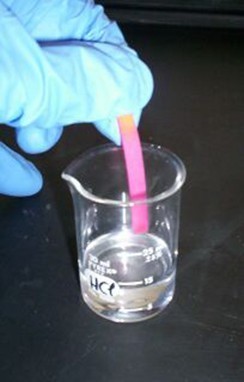
The pH of hydrochloric acid is tested with litmus paper. (credit: David Berardan)
What you’ll learn to do: Rewrite logarithmic expressions using a combination of logarithm rules and formulas
In chemistry, pH is used as a measure of the acidity or alkalinity of a substance. The pH scale runs from 0 to 14. Substances with a pH less than 7 are considered acidic and substances with a pH greater than 7 are said to be alkaline. Our bodies, for instance, must maintain a pH close to 7.35 in order for enzymes to work properly. To get a feel for what is acidic and what is alkaline, consider the following pH levels of some common substances:
- Battery acid: 0.8
- Stomach acid: 2.7
- Orange juice: 3.3
- Pure water: 7 (at 25° C)
- Human blood: 7.35
- Fresh coconut: 7.8
- Sodium hydroxide (lye): 14
To determine whether a solution is acidic or alkaline, we find its pH which is a measure of the number of active positive hydrogen ions in the solution. The pH is defined by the following formula where [latex]a[/latex] is the concentration of hydrogen ion in the solution.
[latex]\begin{array}{lll}\text{pH} & = -\mathrm{log}\left(\left[{H}^{+}\right]\right)\hfill \\ \text{} & =\mathrm{log}\left(\frac{1}{\left[{H}^{+}\right]}\right)\hfill \end{array}[/latex]
[latex]-\mathrm{log}\left(\left[{H}^{+}\right]\right)[/latex] is equal to [latex]\mathrm{log}\left(\frac{1}{\left[{H}^{+}\right]}\right)[/latex] due to one of the logarithm properties we will examine in this section.
Candela Citations
- Revision and Adaptation. Provided by: Lumen Learning. License: CC BY: Attribution
- Precalculus. Authored by: Jay Abramson, et al.. Provided by: OpenStax. Located at: http://cnx.org/contents/fd53eae1-fa23-47c7-bb1b-972349835c3c@5.175. License: CC BY: Attribution. License Terms: Download For Free at : http://cnx.org/contents/fd53eae1-fa23-47c7-bb1b-972349835c3c@5.175.
- College Algebra. Authored by: Abramson, Jay et al.. Provided by: OpenStax. Located at: http://cnx.org/contents/9b08c294-057f-4201-9f48-5d6ad992740d@5.2. License: CC BY: Attribution. License Terms: Download for free at http://cnx.org/contents/9b08c294-057f-4201-9f48-5d6ad992740d@5.2
